COPLAND CSA 150 REVIEW
Copland CSA 150 Integrated Amplifier is distributed in the UK by Absolute sounds and costs £4988. It’s an integrated amp with an onboard DAC and a moving magnet phonostage. Stuart Smith takes it for a whirl.
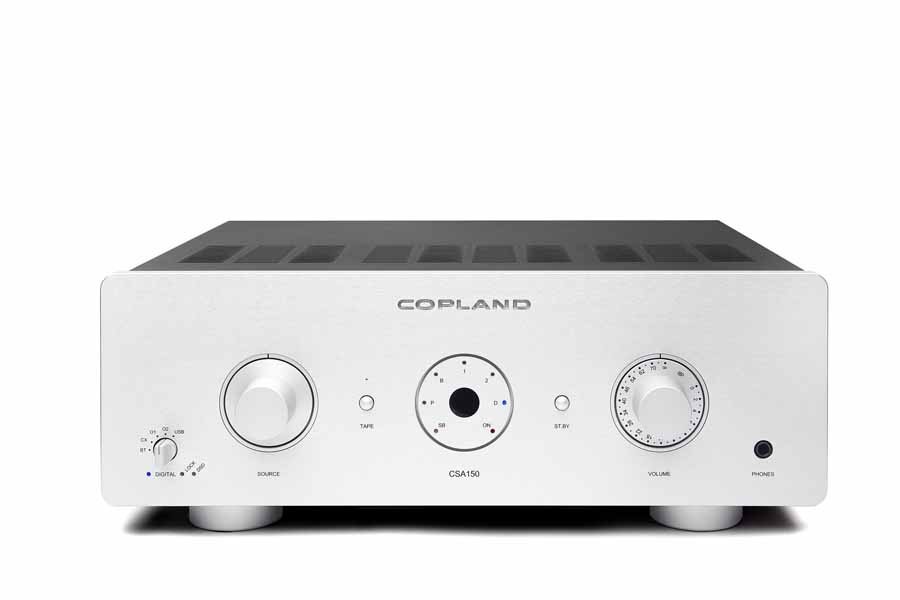
A purposeful front panel sets the tone for this integrated from Copland.
Integrated amplifiers make a lot more sense than separate preamplifier and power-amplifier/s in many ways. First of all, you have everything in one neat box, there are less (potentially) expensive cables needed and you know that the pre-stage has been made with the power stage specifically in mind. However, the panacea for audiophiles the world over seems to be for separate pre and power amps – I suppose, at least in part, this is to do with lots of boxes looking more impressive on the rack, though there are other potential benefits much-touted. In recent years integrated amps have come to be, well, much more integrated and with streaming devices and the like. Today there is no reason that a good integrated can’t be the heart of a very high-quality audio system for the home and without taking up acres of real estate.
Enter the Danish-made Copland CSA-150, a multi-faceted hybrid integrated costing £4988 and being what could well be described as “fully loaded” and distributed in the UK by Absolute Sounds. I’ll look at the individual features of the amp in more detail but to summarise what the CSA-150 can deal with, we have a moving-magnet phonostage, an onboard DAC capable of playing high-resolution files, aptX Bluetooth connectivity (an option), tape in and outs (not so common these days as they once were) and of course the bit that makes your music come out of your speakers.
BUILD AND FEATURES
Build is fantastic and the amp looks purposeful sat on the rack, its cool and minimal brushed aluminium faceplate having a distinct retro feel about it, though it looks thoroughly modern at the same time – modern-retro, perhaps?
The centre of the front-plate is dominated by the circular display with LEDs around it to let you know what source is playing and whether the amp is in standby or on mode – the on light flashes for thirty seconds when the amp is first turned on and then it goes through its ‘start-up procedure’, and then there’s another twenty-second wait before the amp will make any sound.
Left of the main display you have the source selector which is pretty self-explanatory and on the right of the display you’ve got the volume knob. Both feel really nice to use if knob-twiddling is your thing. Other buttons include Tape Monitor and a standby button – both pretty self-explanatory. All the main features of the amp can be controlled by the remote that is pretty nice to use but not in the same league as the likes of Devialet, but then we’re not talking Devialet money here. There is a nice click when changing inputs and the volume is smooth as you like.
Finally, the front panel has a headphone output socket.
Far-left on the front you have a small knob that selects which digital input you are using and you can choose between Bluetooth, coaxial, optical 1, optical 2 and USB, with the relevant inputs being grouped around the back. There’s plenty of inputs here to cater for your streamer, CD player, DVD etc. However, before you can select the input on this smaller knob you need to select D on the main input selector.
The USB input will work with MAC and Linux machines without drivers, but for Windows machines you will need to download and install the ubiquitous Amanero driver on your machine. The USB input is asynchronous, has a power supply and power transformer with its own winding and will work with files up to 32-bit/384 KHz with Copland recommending you listen to files at their native resolution and not upsampled to 384KHz. It will also deal with DSD files up to DSD64/128. The internal DAC that sorts all the above out into tunes you can listen to is based on the ESS9018 chip. There’s no way to stream directly to the Copland which I reckon would help bring this amp very close to being near-perfect, though there is the aptx Bluetooth option to ‘stream’ to.
There an onboard phonostage for moving magnet or high-output MC cartridges, and whilst most will find this perfectly adequate, I reckon the amp could well do with being able to handle the usually more expensive low-output moving coil variants. There’s no way to change settings of the phonostage and you are left with an input impedance of 47K ohms and a capacitance of 200pF. I had no issues at all with the Sumiko MM I used.
Over and above the record player inputs and the digital inputs there are three unbalanced RCA inputs and a balanced XLR input.
Should you wish you can output the pre-stage out to another amp and there’s a tape out that will record whatever is playing on the CSA-150.
Output is a healthy 2 x 145 W of Mosfet AB power into 8 and 2 x 230 W into 4 ohms with a single 6922 valves being used.
Connection to speakers is via a pair of nicely done binding posts but there’s a section of the user manual that talks about “Speaker Polarity”. In short, the absolute phase at the speaker terminals is 180 degrees with the black speaker terminal being grounded. So to get the speakers in-phase you need to connect your speaker cables red to black and black to red. I found this a bit confusing but Copland reckon this has been done because of the tube line stage and its design and that the black terminal should be recognised as the ground. There is the danger here that some may well not read the manual and connect the speakers up incorrectly.
So, on the face of it what we have here with the Copland CSA-150 is a great looking, well built integrated that covers just about all bases with regards what the average user is going to want, and at just shy of five grand it seems to offer a good deal for the money, whilst clearly exuding a goodly measure of high-endiness.
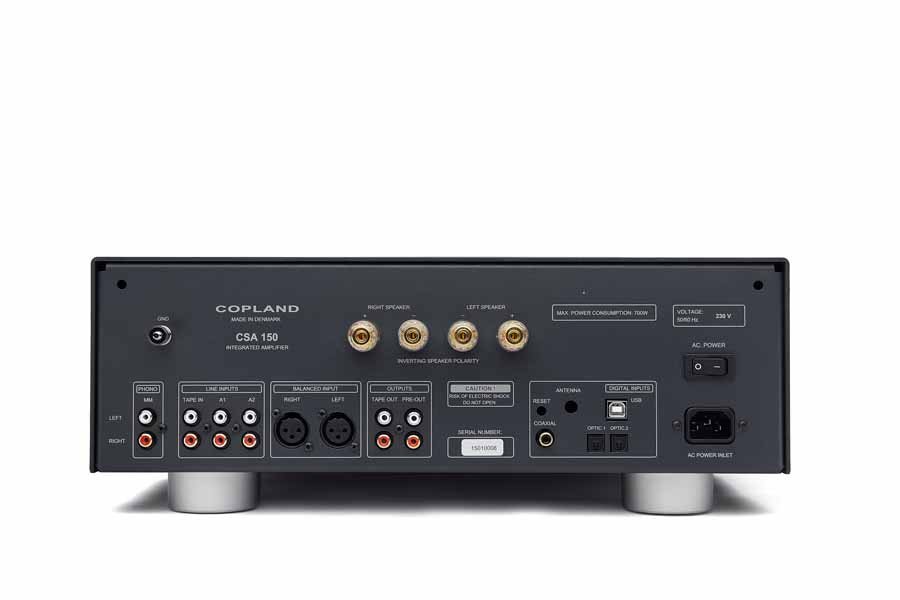
The back of the Copland showing plenty of inputs.
THE SOUND
There’s no doubt that from the off this amplifier is a nice bit of kit and I first slotted it into our second system where we try to stick to under five grand a box. Truth is this is s very good and revealing system that, despite having a modest Raspberry pi as its front end (albeit feeding zeros and ones to the excellent Lab 12 dac), I absolutely adore listening to. The power amp in this system is usually the big old (but totally renovated by Krell) Krell with a LAB 12 pre1 which is, at this price point, a formidable duo. This system also gives us the opportunity to switch out various speakers easily and quickly to offer a more rounded and relevant overview of the products we get to review.
First up I connected the Copland to the DAC and had the Falcon LS3/5a Gold Label speakers wired in. These speakers have, despite my liking for wholly (apparently) inappropriate music, become a bit of a favourite and are really revealing through the mids and tops, and whilst the bass may be limited, in this room I have no desire to connect up the couple of subs we have to hand.
Streaming Cat Stevens’ Teaser and the Firecat is a real pleasure with the amplifier having a deftness of touch that allows the highly distinctive vocal to shine through. There is a sweetness and slight warmth to the amp through the mids that really allow this album to come to life and engage the listener. There is speed to the acoustic instruments that makes them clean and without haze or smear. The amp is also dead quiet with music coming from a silent background which adds to the cleanliness and precision of what you are listening to.
However, switching out the Falcons for the more difficult to drive Diptique dp 77 things really come alive and I can’t help to turn the volume up. The Copland powers these speakers to volumes I’d be worried about pushing the LS3/5as to, and whilst the volume is increased I’m still able to enjoy that sweet and mellifluous mid-band. Here we have a very good match between amp and speakers indeed. Very good! Occasionally I’ve had amps run out of steam pushing these speakers and that’s why we have the Krell in place, but I’m happy to report that the Copland demonstrates no such inadequacies. I put a lot of music through the partnering and whether it was pounding techno or more subtle classical piano, I never felt I was listening to anything but a very good system. I’ve sort of given my thoughts away there, haven’t I! Bass heft and clout were wonderful but without taking over.
Jeff Buckley’s Hallelujah sounds splendid with real presence and attack to the sharp guitar. Effects used are very apparent, and whilst the presentation is highly detailed I’m not getting the feeling that it’s exaggerated for effect. In fact, this is a real goosebumps experience of a listen. As mentioned the amp is dead quiet and its very easy to hear the tape noise on this track which adds to the ambience somehow. The vocal sounds absolutely wonderful and “there” in the room and with excellent insight into Buckley’s delivery. The amp adds a slight warmth to the midband that I really enjoyed, but in the main the Copland let the LAB 12’s character shine out.
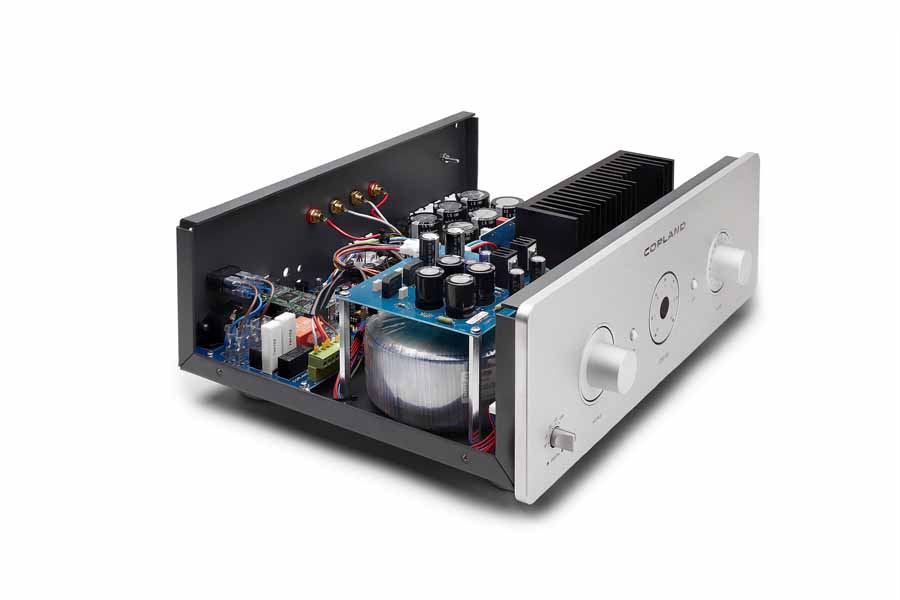
The inside of the Copland is well laid out and ordered.
Now the Copland, pi, LAB12 and Diptiques is a combo that comes in at around ten thousand of your English beer tokens and I think for that you are getting an exceptionally capable HiFi. Ordinarily, I’d always suggest spending the majority of your budget on loudspeakers, but this amp brings something to the party that just makes it a bit of a standout, though of course, we have the LAB 12 adding its little bit of magic.
Switching the reference DAC out and using the onboard DAC is as easy as you like. Plug the Pi into the back of the amp via USB, find the amp on Roon set up, click it as the source, and hey presto you have music. Drivers are needed for Windows, as I outlined previously.
Playing Hallelujah still sounds very fine indeed, though the former set up has it by a smidgin, though you are of course making a saving of the best part of three grand on the deal. There is still the clean and mellifluousness of Buckley’s vocal shining through, and there is still plenty of detail to the presentation, with the former DAC really only having it on that sprinkling of magic that it brings to the sound that’s hard to put a finger on. Changing the tempo up a gear and playing Underworld’s Drift Episode 1 and you have that heft and weight to the delivery, but there is speed from the amp too – no overblown bass and no loss of control of the speakers. On the bass front, and even with these difficult speakers in the chain, the amp doesn’t skip a beat. I’d sort of liken the Copland to the Krell power amp in a lot of ways – it just gets on with the job in hand, doesn’t make a fuss, and delivers music!
Thinking about it, this amp gives you real options from the off in that it has everything on board that you need for a streamlined digital system that really delivers on sonic performance. Out of the box you can add the streamer of your choice and a pair of speakers and off you go. Should you get the urge down the line you can always add a better DAC – most will not feel this need as the onboard DAC is more than adequate to my way of thinking.
But the CSA 150m is a bit more accomplished on the features front, and those looking to embrace vinyls (sic) are given the moving magnet phonostage as a plug and play option. Now here is where the Copland comes into its own and in the same breath misses a trick. Personally I pretty much exclusively use low output moving coil cartridges and have just one moving magnet cartridge in the collection to allow for reviewing phonostages fully, and of course, amps like this that don’t have the provision of an MC input. Now, I say that this is missing a trick in that I reckon the amp is well good enough to handle a very decent MC vinyl front end. However, that would add to the cost, and in having a moving magnet stage that will satisfy most folk investing this kind of money the amp makes great sense – if not then you can add either an all-singing phonostage in front of the amp, or add a step-up transformer. With our Sumiko Olympia cartridge, it’s a very enjoyable listen, being dynamic and quiet. But, there is a clear step up in performance when adding our reference phonostage and a good MC cartridge which sort of suggests that the pre and power stage of this amp are very, very capable. These are choices you can make and spend more on if you feel the itch down the line – the vast majority will not feel this need!
Plug in a set of headphones into the properly sized quarter-inch jack socket on the front panel and the sound through the speakers stops. I plugged in our Audeze LCD closed backs and the amp drove them very loud indeed – to the point I had to crank back the volume knob a good few steps. Again, there are better headphone amps out there, but the folk that buy the Copland aren’t going to be using headphones as their main listen, and as such the onboard offering will suffice. Actually, it’s very enjoyable and it didn’t feel out of company or depth with the Audeze cans.
Bluetooth is something I really just don’t get, but that’s more to do with me being a bit of a stuck in the mud old duffer. However, I understand it is something that young folk, and those more in tune with the modern world use a good deal and so its inclusion on the CSA-150 is sensible. The version here is the superior aPTX which is supposed to offer better sound quality over standard Bluetooth. Using it is easy enough – select D for digital on the amps selector knob, switch to BT on the amps digital selector knob, open up your phone, press Bluetooth and then “pair new device” and the phone talks to your amp in a matter of a few seconds. Sound quality is clearly inferior to the other digital inputs and to my ears by quite a margin, but then we are dealing with an inferior mode of getting the tunes to the amp in the first place. I’d be happy to use the Bluetooth input whilst pottering about or for playing playlists for a party but, and this goes for all Bluetooth, that’s about it.
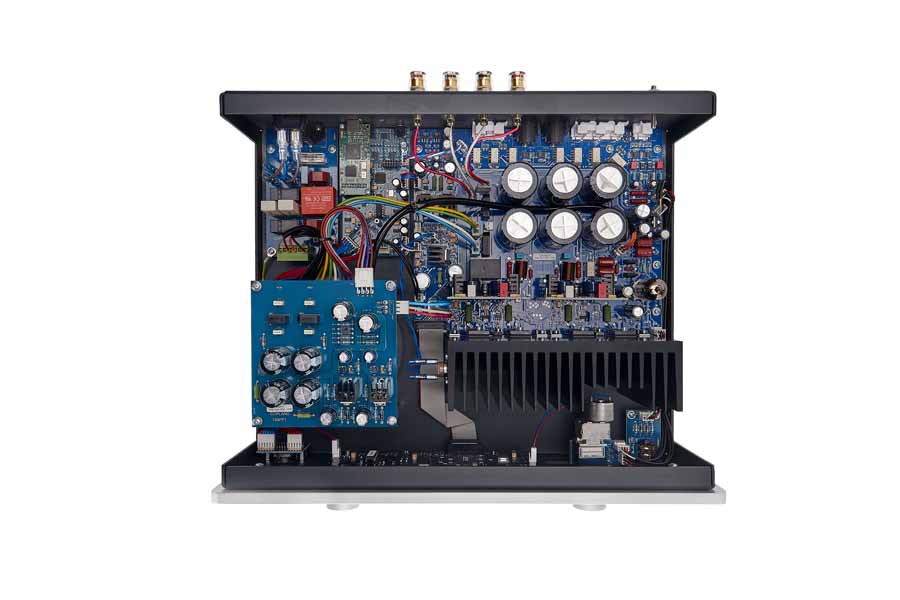
More of the inside of the Copland integrated
CONCLUSION
Here’s how I see the CSA-150: Imagine you buy a “forever home” that has everything you could possibly want for you, your partner, and a couple of kids. You feel wonderfully comfortable and completely satisfied with your lot, but through life you see wages increase and fancy a bigger kitchen, though you don’t actually need a bigger kitchen as the current one is perfectly good. Do you move to a new home and start afresh, or do you think that the core home you have is so wonderful already that you think that adding a nice extension will be the better option? Like the forever home, the Copland is perfectly good, but you may feel that you want to add a better phonostage, a different DAC, or a better headphone amp at some point, whilst the core of the system (the pre and amp) provide a solid foundation on which to build… should the urge take you. Personally, apart from perhaps adding the SUT/MC phonostage, I wouldn’t bother.
Power and an ease of delivery are the main things that I took from my time with this integrated amplifier. There is detail, control and not a little feeling that you are getting a whole lot of amplifier for your money. It is well featured and built very solidly. I’d certainly have no qualms in having this amp at the heart of one of our systems.
For those starting out on their HiFi journey, the Copland, partnered with a suitably good pair of loudspeakers, could well be an ideal starting point that you may well never feel the urge to build on, though it is by no means a drop in the ocean financially speaking.
The long and short of this amp is that it packs an awful lot into a package that could become the heart of any system. I loved it, and had it had an MC phono and perhaps onboard streaming it would have got out highest Editors Choice award.

AT A GLANCE
Build Quality:
Very nicely put together and looks seriously good on the rack. The feature set is very good with the onboard MM phonostage, DAC and Bluetooth connections over and above the usual standard fare. Remote is pretty good and proportionate with the amplifier’s price.
Sound Quality:
Powerful and yet subtle and detailed when needed. Will drive difficult loads with ease.
Value For Money:
It’s not cheap by any stretch of the imagination but it packs a lot into the box and offers enough by way of features for most people as it stands, safe in the knowledge that the pre and amp are good enough to warrant the addition of a better phonostage down the line.
We Loved:
Solid Build
Great looks
Well featured for most circumstances
Good headphone amp
Solid bass and very smooth and enjoyable mid-band
Upper frequencies never became over-bearing
Tape monitoring onboard
We Didn’t Love So Much:
No MC cartridge provision
The speaker connections are confusing, though explained in the manual
Be nice if you could just plug the amp into the home network via RGB or even better wireless
Price: £4988
Elevator Pitch Review: A well-featured and very nicely put together amplifier that deals with digital and analogue sources with aplomb and with onboard DAC and phonostage. It sounds as solid as it looks, but also has a good deal of subtlety to its presentation. If you are looking for a one-box solution that you just need to add a source to, then you could do a lot worse than this Danish offering. The downsides are that its phonostage is MM only and there is no onboard streaming.
Stuart Smith
Review Equipment: Diptique dp77 and Falcon LS3/5a Gold speakers. LAB12 dac with Raspberry Pi streamer. Cables by Atlas and Chord.
CSA150 Specifications
Output power: 2*150 W into 8 ohms load.
Minimum load: 2 ohms
Analog Inputs: 1*balanced (XLR)
3*unbalanced (RCA)
Digital Inputs: 1*coaxial S/PDIF.
2*optical S/PDIF.
1* USB.
1* aptX HD Bluetooth (Optional Extra)
Line output: 1*unbalanced (RCA)
1* Pre-out /unbalanced variable (RCA)
Line input impedance: 50 K ohms
Phono input impedance: 47 K ohms (MM)
Phono input Capacitance: 200 pF
Line Inputs sensitivity: 270 mV
Phono sensitivity: 2.6 mV
Frequency response: 10 Hz – 150 kHz -3dB
T.H.D: Better than 0.04 %
Signal / noise IHF-A): Better than 90dB
Phase: Inverting
Headphone amp. Gain: 22 dB @ 100 ohms load impedance
Headphone amp. Out imp. 40 ohms
Headphone amp. T.H.D. Better than 0.04 %
Headphone amp. Freq. resp. 10 Hz – 150 kHz / -3dB
Vacuum tubes: 1 pc. 6922
Power consumption: Max.800 W
Dimensions: 435mm (w) x 164mm (H) x 370mm (D)
Shipping weight: 15 Kg.













































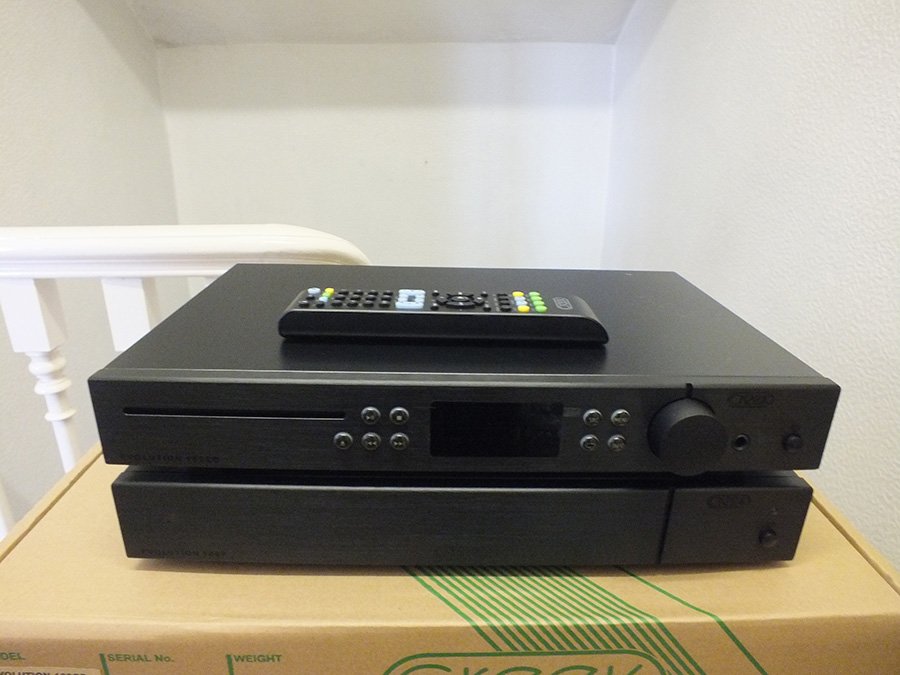









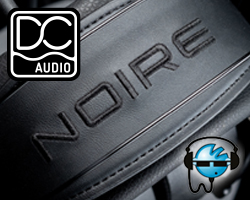









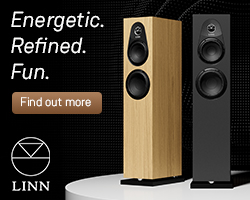


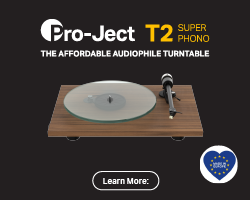
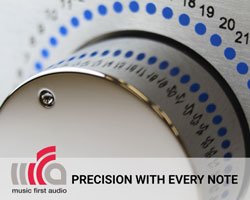

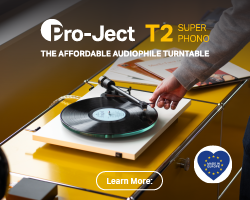




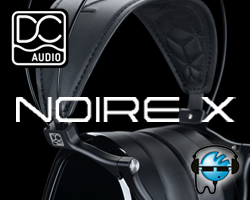








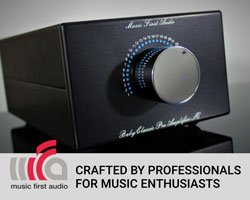



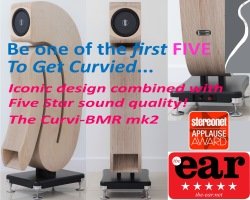












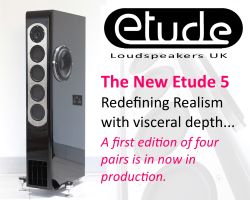


































































You must be logged in to leave a reply.